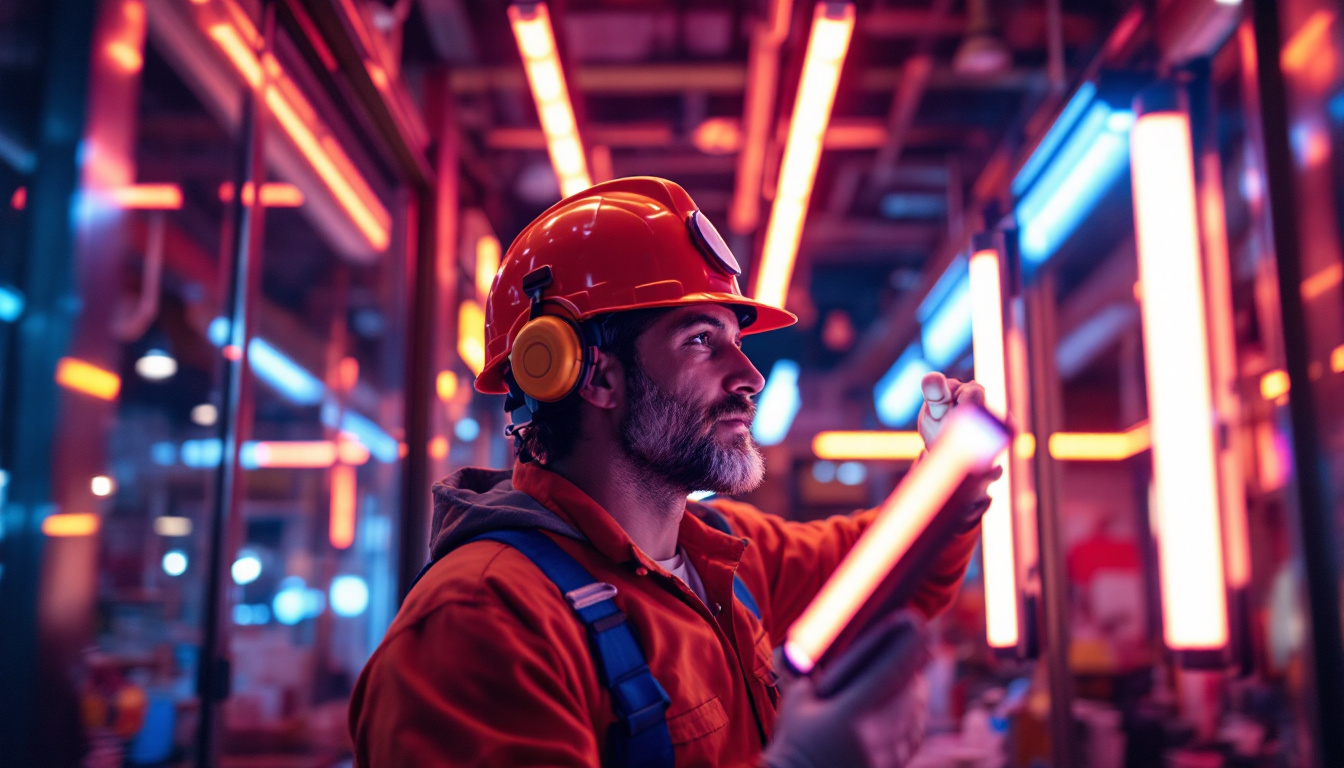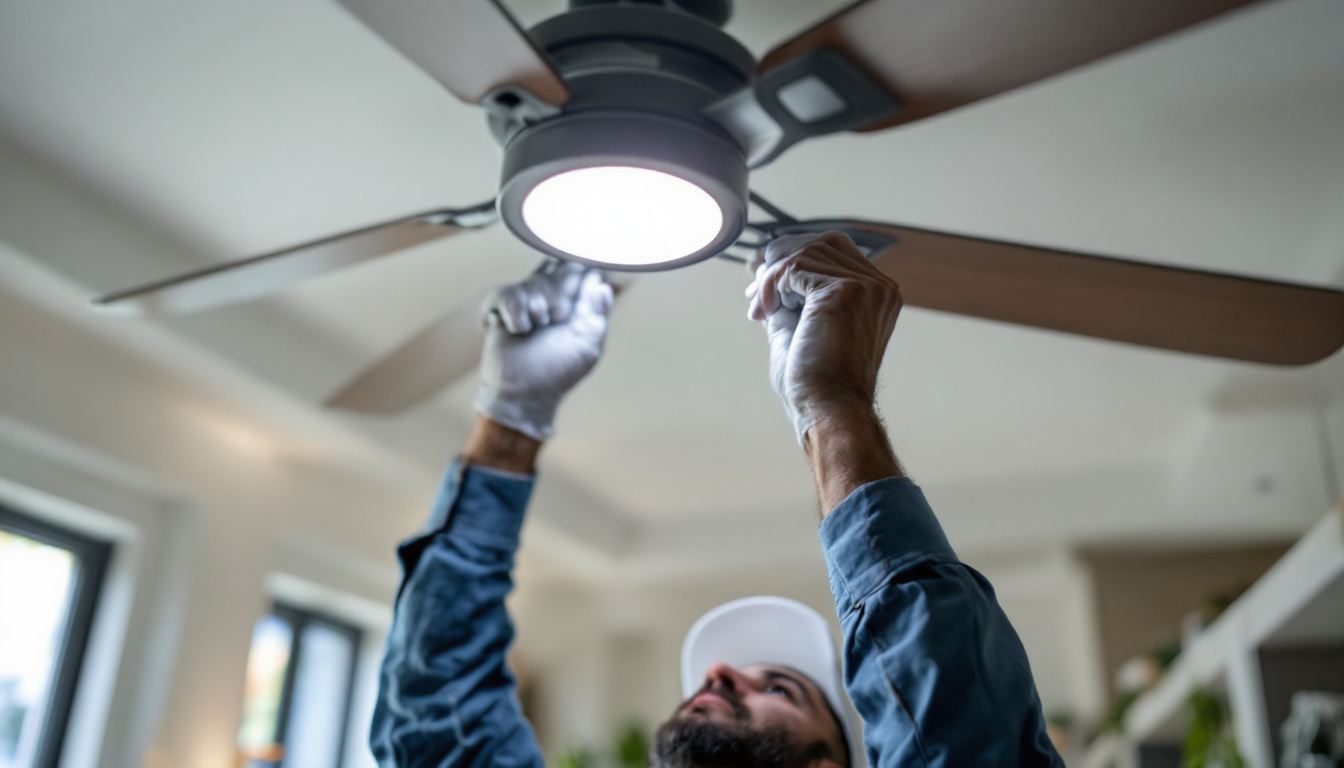
In the ever-evolving world of lighting, contractors are faced with a myriad of choices when it comes to selecting the right type of lighting for their projects. Among the most popular options are LED lights and fluorescent lights. Each has its unique advantages and disadvantages, and understanding these can significantly impact a contractor’s business. This article delves into the comparison between LED and fluorescent lights, exploring how this knowledge can enhance a lighting contractor’s service offerings and ultimately boost their business.
Light Emitting Diodes (LEDs) are semiconductor devices that emit light when an electric current passes through them. Unlike traditional bulbs, LEDs do not rely on filaments or gas to produce light. This technology allows for a more efficient energy consumption, resulting in lower electricity bills and a longer lifespan.
LED lights are available in various colors and intensities, providing flexibility for different applications. Their ability to produce bright, focused light makes them ideal for both indoor and outdoor settings. Additionally, LEDs are known for their durability and resistance to shock and vibration, which is a significant advantage in commercial and industrial environments. The compact size of LEDs also allows for innovative designs and applications, such as in signage, automotive lighting, and even in wearable technology, making them a versatile choice for modern lighting solutions.
Furthermore, the environmental impact of LED lighting is considerably lower than that of traditional lighting options. LEDs are free from toxic elements like mercury, which is commonly found in fluorescent bulbs, and they are 100% recyclable. This eco-friendly aspect has led to an increased adoption of LED technology in various sectors, including residential, commercial, and municipal lighting projects, contributing to a more sustainable future.
Fluorescent lights operate by passing an electric current through a gas, which then produces ultraviolet light. This UV light interacts with a phosphor coating inside the bulb, resulting in visible light. Fluorescent lights have been a staple in commercial and residential settings for decades, primarily due to their cost-effectiveness and efficiency compared to incandescent bulbs.
While fluorescent lights are available in various shapes and sizes, they typically emit a softer, diffused light. This can be beneficial in environments where a more ambient lighting effect is desired. However, they are generally less energy-efficient than LEDs and have a shorter lifespan, which can lead to higher replacement costs over time. Additionally, fluorescent lights can sometimes flicker and take a moment to warm up, which may not be ideal in settings requiring instant illumination.
Moreover, the color rendering index (CRI) of fluorescent lights can vary significantly, which affects how colors appear under their illumination. While some fluorescent bulbs are designed to mimic natural daylight, others may produce a harsher light that can distort the perception of colors. This characteristic makes careful selection essential for applications such as photography studios or retail environments, where accurate color representation is crucial. Despite these drawbacks, the affordability and widespread availability of fluorescent lighting continue to make it a popular choice for many applications, particularly in commercial spaces where budget constraints are a primary concern.
energy efficiency is one of the most compelling reasons for contractors to consider LED lighting. LEDs consume significantly less power compared to fluorescent lights, often using up to 75% less energy. This not only translates to lower electricity bills for clients but also contributes to a reduced carbon footprint, aligning with the growing demand for sustainable solutions.
Moreover, the long lifespan of LED lights—often exceeding 25,000 hours—means that contractors can offer their clients a more durable and cost-effective option. This longevity reduces the frequency of replacements, which can be an attractive selling point for commercial clients looking to minimize maintenance costs.
While fluorescent lights are less energy-efficient than LEDs, they still offer a budget-friendly option for many projects. The initial cost of fluorescent bulbs is typically lower than that of LEDs, making them an appealing choice for contractors working with tight budgets. However, it is essential to consider the long-term costs associated with energy consumption and replacement.
Fluorescent lights generally have a lifespan of around 7,000 to 15,000 hours, which means they will need to be replaced more frequently than LEDs. This can lead to increased labor costs for contractors and potential dissatisfaction for clients who may not be aware of the long-term implications of their lighting choices.
One of the standout features of LED lights is their ability to produce bright, high-quality light. They are available in a range of color temperatures, from warm white to cool daylight, allowing contractors to tailor lighting solutions to specific client needs. This flexibility is particularly beneficial in commercial applications, where different tasks may require varying levels of brightness and color accuracy.
Additionally, LEDs have excellent color rendering capabilities, which means they can accurately reproduce colors in a way that is visually appealing. This is crucial in settings such as retail stores, art galleries, and restaurants, where the quality of light can significantly impact the overall ambiance and customer experience.
Fluorescent lights, on the other hand, emit a softer, more diffused light that can create a pleasant atmosphere in various environments. They are commonly used in office spaces, schools, and hospitals, where a more subdued lighting effect is often preferred. However, the color rendering index (CRI) of fluorescent lights is generally lower than that of LEDs, which can affect how colors appear in different settings.
While fluorescent lights can be suitable for many applications, contractors must be mindful of the specific lighting needs of their clients. In some cases, the softer light quality may not be adequate for tasks that require precision and clarity, making it essential to assess each project’s requirements carefully.
As sustainability becomes increasingly important in the construction and lighting industries, the environmental impact of lighting choices is a significant consideration for contractors. LED lights are often touted as the more environmentally friendly option due to their energy efficiency and long lifespan.
Moreover, LEDs do not contain hazardous materials such as mercury, which is present in fluorescent bulbs. This makes LED disposal easier and safer, reducing the risk of environmental contamination. By promoting LED lighting solutions, contractors can position themselves as environmentally conscious providers, appealing to clients who prioritize sustainability in their projects.
Fluorescent lights, while still a viable option for many applications, pose challenges in terms of disposal due to their mercury content. Improper disposal can lead to environmental hazards, and contractors must be aware of local regulations regarding the disposal of fluorescent bulbs. This can add an additional layer of complexity to projects and may deter environmentally conscious clients.
Contractors should educate their clients on the importance of proper disposal and recycling of fluorescent lights to minimize their environmental impact. By doing so, they can foster a sense of responsibility and promote sustainable practices within their client base.
When deciding between LED and fluorescent lighting, contractors must weigh the initial investment against long-term savings. While the upfront cost of LED lights may be higher, the energy savings and reduced maintenance costs can lead to significant savings over time.
For clients who are budget-conscious, it may be tempting to opt for fluorescent lights due to their lower initial cost. However, contractors should present a comprehensive analysis of the total cost of ownership, including energy consumption, lifespan, and maintenance requirements. This can help clients make informed decisions that align with their long-term goals.
To further encourage clients to consider LED lighting, contractors can explore financing options and incentives available for energy-efficient upgrades. Many utility companies offer rebates for the installation of LED lights, which can offset the initial investment and make the transition more financially feasible for clients.
By staying informed about available incentives, contractors can provide valuable guidance to their clients, helping them navigate the financial aspects of their lighting choices. This not only enhances the contractor-client relationship but also positions the contractor as a knowledgeable resource in the industry.
For lighting contractors, education is key to helping clients make informed decisions. By providing comprehensive information about the differences between LED and fluorescent lighting, contractors can empower clients to choose the best option for their specific needs. This can involve hosting workshops, creating informative brochures, or utilizing digital platforms to share knowledge.
Additionally, offering consultations to assess clients’ lighting needs can further enhance the contractor’s reputation as a trusted advisor. By demonstrating expertise and a commitment to client satisfaction, contractors can build long-term relationships that lead to repeat business and referrals.
In a competitive market, effective marketing strategies can set a lighting contractor apart from the rest. Highlighting expertise in energy-efficient lighting solutions, such as LEDs, can attract clients who prioritize sustainability and cost savings. This can be achieved through targeted advertising, social media campaigns, and showcasing successful projects that emphasize the benefits of LED lighting.
Additionally, obtaining certifications or partnerships with reputable lighting manufacturers can enhance credibility and instill confidence in potential clients. By positioning themselves as leaders in the industry, contractors can create a strong brand presence that resonates with their target audience.
In the debate between LED and fluorescent lighting, there is no one-size-fits-all answer. Each option has its unique advantages and drawbacks, and the choice ultimately depends on the specific needs of the project and the client. However, understanding the nuances of both lighting types can empower contractors to make informed recommendations that align with their clients’ goals.
By embracing the benefits of LED lighting, contractors can enhance their service offerings, reduce costs for clients, and position themselves as environmentally conscious providers. Furthermore, investing in education and marketing strategies can help contractors effectively communicate the value of their expertise, ultimately leading to business growth and success.
As the lighting industry continues to evolve, staying informed about the latest trends and technologies will be crucial for contractors looking to thrive in a competitive landscape. By prioritizing energy efficiency, quality, and sustainability, lighting contractors can not only meet the demands of their clients but also contribute to a brighter, greener future.
Ready to elevate your lighting game and give your clients the best value? Look no further than LumenWholesale for all your lighting needs. With our premium, spec-grade lighting products at wholesale prices, you can confidently offer energy-efficient and sustainable LED solutions that align with your clients’ goals. Enjoy the convenience of bulk buying with free shipping and no hidden fees. Make the smart choice for your business and visit LumenWholesale today to discover how we can brighten your projects while boosting your bottom line.

Discover essential insights into ceiling fan switches that every lighting contractor should know.
Discover how LED tape lights under cabinets can transform your lighting installation projects with enhanced efficiency and aesthetics.

Discover how pendant lamps can streamline projects for lighting contractors.

Discover the essential fluro light wiring diagram every lighting contractor must know.